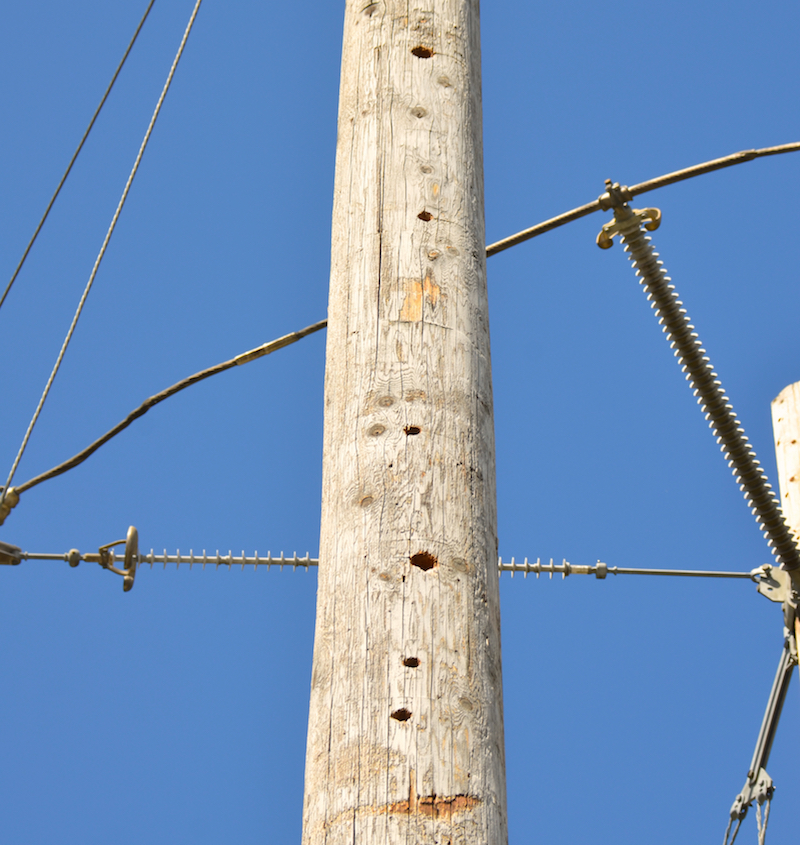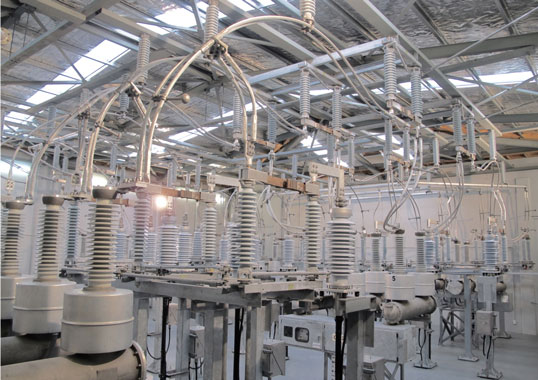Most discussions relating to birds and overhead lines tend to focus either on bird mortality or on bird-induced outages. But not all bird problems involve threats to protected species or impact a line’s performance. In the case of woodpeckers, for example, the key issue is progressive deterioration in sheer and bending strength due to holes pecked into wood pole framing. There are several theories as to why these birds find utility poles attractive, but most conclude that these present a convenient vantage point for announcing territory and detecting predators.
Several years ago, INMR met with engineers at one affected power utility in western Canada to review how this problem was being addressed.

The normal life of a wood pole in the affected service area in western Canada is between 50 and 60 years. However, in extreme cases of woodpecker damage, certain structures need to be replaced after only a few years. This makes these birds more than just a nuisance and in fact an asset management challenge that must be dealt with properly.
The affected utility in this case normally conducts assessments of all its overhead lines on an 8-year cycle. This includes both below and above grade inspections of each structure. Apart from checking samples of wood poles below grade for issues such as moisture penetration, visual assessment is performed of structures, cross-arms, line hardware and conductors. In recent years, this inspection protocol highlighted what appeared to be a growing problem with woodpecker damage. For example, during these annual condition assessments a large number of structures were identified as having woodpecker holes. This initiated broader discussion about how woodpeckers might be affecting the system.
Recent practice has been that line inspection personnel in the field assess the extent of woodpecker damage to poles and decide whether to replace any affected structure or whether more detailed inspection may be required. Moreover, starting 2017, data on numbers of woodpecker holes began to be systematically collected and studied to determine whether the problem was stable or increasing, due to factors such as climate change.



Another topical issue is how best to deal with poles where there are already holes but where there is no perceived urgency for replacement. In the case of the affected utility, up until 2018 there were no specific cases of poles that failed mechanically due solely to woodpecker damage. This suggested that the problem was not at a critical stage but rather only a potential threat to be monitored and assessed.
One remedial approach tried elsewhere in Canada has been to fill holes with a special compound to prevent the pole’s interior being exposed to climate and ageing prematurely. But the filler material does not contribute to restoring the lost mechanical strength of a pole and may actually result in new holes in the future if woodpeckers come back to nest and find earlier holes filled. There are environmental concerns as well.


In terms of measures to prevent the problem in the first place, a number of devices have been evaluated to discourage woodpeckers from alighting on pole framing. These include so-called ‘eagle eyes’ as well as rotating shiny wheels since it has been suggested these birds avoid reflected silver light. However, experience has shown that such devices are not durable and may fall off over time.

Another potential measure to protect wood poles from woodpecker damage is wrapping them in steel mesh. However, this has created concern about how a steel fabric wound over a wood structure will impact its electrical properties and worker safety since it effectively turns the wood pole into a steel pole and changes its BIL. There are also related grounding and bonding issues. Finally, the mesh could affect ease of climbing. A plastic mesh has also been evaluated but then the question becomes how long these will survive if damaged by repeated climbing. Another doubt is whether the material can stand up to high UV and weathering.

Wood pole framing is common on transmission networks across the globe because it offers easy access for lines workers. Changing to steel or concrete is an obvious solution to avoid woodpecker damage but for many comes with the challenge of transporting and erecting much heavier structures, often at remote sites. Moreover, both materials offer less BIL than wood and thereby change a line’s electrical characteristics.

Yet another option is composite fiberglass poles that are light and offer lower installation costs but can be up to three times more costly than wood. Delivery lead times can also be problematic due to fewer suppliers. Apart from these disadvantages, such structures are also more difficult to climb and often require use of a bucket truck for maintenance. Nevertheless, according to engineers, they do present a long-term solution for high problem areas looked at on a case-by-case basis.

Finally, several years ago, a pilot project was launched to investigate yet another solution – wrapping poles in a special polymeric fabric designed expressly for this type of application. These wraps are reportedly easy to install, have no impact on a pole’s BIL and create no new grounding or bonding concerns. The wrap, which has been tested for UV and weathering performance, also does not affect worker access to the pole or create additional safety issues.
With this additional remedial measure, utilities have a range of options once poles with woodpecker holes have been identified during inspection cycles. Asset management staff can decide either that the problem is too small to worry about or that it is better to wrap an affected pole because it seems a target for ongoing damage. In more critical cases where there is already significant damage, the pole can be replaced either with wood or composite types. The choice in each case will depend on criticality of line and ease of access to the site for installation crews.






















